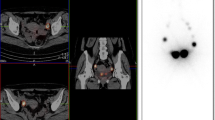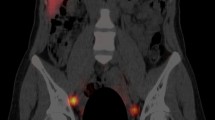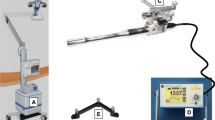Abstract
Purpose
SPECT/CT after pericervical injection of technetium-99 m-nanocolloid was shown to be suitable for sentinel lymph node (SLN) mapping in endometrial cancer (EC). The aim of this study was to analyze factors affecting successful SLN detection by means of SPECT/CT such as imaging findings, patient characteristics and tumor biology in a large cohort of patients.
Methods
One hundred and forty-five consecutive patients suffering from EC who received pre-surgical SLN mapping at our institution between 2011 and 2016 were included in this analysis. SPECT/CT data of abdomen and pelvis (mean 4:20 ± 1:20 h p.i.) were acquired after pericervical injection of technetium-99 m-nanocolloid (mean 230 ± 45 MBq) in all patients. Surgical staging was performed on the day after. Acquisition parameters, patient characteristics, SPECT/CT findings as well as histopathological results were collected.
Results
A total of 282 SLNs were identified by means of SPECT/CT. Overall, preoperative and intraoperative SLN detection rates were 86%, 76% and 74% respectively. The most important factor associated with failure to detect SLNs was the presence of high bone marrow on SPECT/CT (p = 0.005). Peritoneal/abdominal radioactivity was also associated with missed SLN detection in SPECT/CT (p = 0.02). However, the presence of liver/spleen uptake on its own was not predictive for detection failure. Low numbers of detected SLNs in SPECT/CT were slightly related with older age and lower injected activity. No significant influence was found for the parameters of tumor histology and stage, lymph node involvement and the time gap between injection and imaging.
Conclusions
Venous drainage as indicated by bone marrow uptake is the most important factor associated with scintigraphic SLN detection failure. Moreover, high peritoneal and abdominal activity was also associated with detection failure. Thus, meticulous application of the radiotracer is crucial in EC.



Similar content being viewed by others
References
Ferlay J, Steliarova-Foucher E, Lortet-Tieulent J, Rosso S, Coebergh JW, Comber H, et al. Cancer incidence and mortality patterns in Europe: estimates for 40 countries in 2012. Eur J Cancer (Oxf, Engl: 1990). 2013;49:1374–403. doi:10.1016/j.ejca.2012.12.027.
Siegel RL, Miller KD, Jemal A. Cancer statistics, 2015. CA Cancer J Clin. 2015;65:5–29. doi:10.3322/caac.21254.
Frost JA, Webster KE, Bryant A, Morrison J. Lymphadenectomy for the management of endometrial cancer. The Cochrane database of systematic reviews. 2015:CD007585. doi:10.1002/14651858.CD007585.pub3.
Bogani G, Dowdy SC, Cliby WA, Ghezzi F, Rossetti D, Frigerio L, et al. Management of endometrial cancer: issues and controversies. Eur J Gynaecol Oncol. 2016;37:6–12.
Todo Y, Kato H, Kaneuchi M, Watari H, Takeda M, Sakuragi N. Survival effect of para-aortic lymphadenectomy in endometrial cancer (SEPAL study): a retrospective cohort analysis. Lancet (Lond, Engl). 2010;375:1165–72. doi:10.1016/s0140-6736(09)62002-x.
Holloway RW, Gupta S, Stavitzski NM, Zhu X, Takimoto EL, Gubbi A, et al. Sentinel lymph node mapping with staging lymphadenectomy for patients with endometrial cancer increases the detection of metastasis. Gynecol Oncol. 2016;141:206–10. doi:10.1016/j.ygyno.2016.02.018.
Leitao Jr MM, Khoury-Collado F, Gardner G, Sonoda Y, Brown CL, Alektiar KM, et al. Impact of incorporating an algorithm that utilizes sentinel lymph node mapping during minimally invasive procedures on the detection of stage IIIC endometrial cancer. Gynecol Oncol. 2013;129:38–41. doi:10.1016/j.ygyno.2013.01.002.
Khoury-Collado F, St Clair C, Abu-Rustum NR. Sentinel lymph node mapping in endometrial cancer: an update. Oncologist. 2016;21:461–6. doi:10.1634/theoncologist.2015-0473.
Zahl Eriksson AG, Ducie J, Ali N, McGree ME, Weaver AL, Bogani G, et al. Comparison of a sentinel lymph node and a selective lymphadenectomy algorithm in patients with endometrioid endometrial carcinoma and limited myometrial invasion. Gynecol Oncol. 2016;140:394–9. doi:10.1016/j.ygyno.2015.12.028.
Gherghe M, Bordea C, Blidaru A. Sentinel lymph node biopsy (SLNB) vs. axillary lymph node dissection (ALND) in the current surgical treatment of early stage breast cancer. J Med life. 2015;8:176–80.
New ASCO, SSO guidelines for sentinel lymph node biopsy in melanoma. Oncology (Williston Park, NY). 2012;26:841–2.
Kang S, Yoo HJ, Hwang JH, Lim MC, Seo SS, Park SY. Sentinel lymph node biopsy in endometrial cancer: meta-analysis of 26 studies. Gynecol Oncol. 2011;123:522–7. doi:10.1016/j.ygyno.2011.08.034.
Ahmed M, Purushotham AD, Horgan K, Klaase JM, Douek M. Meta-analysis of superficial versus deep injection of radioactive tracer and blue dye for lymphatic mapping and detection of sentinel lymph nodes in breast cancer. Br J Surg. 2015;102:169–81. doi:10.1002/bjs.9673.
Hoogendam JP, Veldhuis WB, Hobbelink MG, Verheijen RH, van den Bosch MA, Zweemer RP. 99mTc SPECT/CT versus planar lymphoscintigraphy for preoperative sentinel lymph node detection in cervical cancer: a systematic review and Metaanalysis. J Nucl Med. 2015;56:675–80. doi:10.2967/jnumed.114.152439.
Buda A, Elisei F, Arosio M, Dolci C, Signorelli M, Perego P, et al. Integration of hybrid single-photon emission computed tomography/computed tomography in the preoperative assessment of sentinel node in patients with cervical and endometrial cancer: our experience and literature review. Int J Gynecol Cancer. 2012;22:830–5. doi:10.1097/IGC.0b013e318253496f.
Sawicki S, Kobierski J, Lapinska-Szumczyk S, Lass P, Cytawa W, Bianek-Bodzak A, et al. Comparison of SPECT-CT results and intraoperative detection of sentinel lymph nodes in endometrial cancer. Nucl Med Commun. 2013;34:590–6. doi:10.1097/MNM.0b013e328360d8cc.
Perissinotti A, Paredes P, Vidal-Sicart S, Torne A, Albela S, Navales I, et al. Use of SPECT/CT for improved sentinel lymph node localization in endometrial cancer. Gynecol Oncol. 2013;129:42–8. doi:10.1016/j.ygyno.2013.01.022.
Mucke J, Klapdor R, Schneider M, Langer F, Gratz KF, Hillemanns P, et al. Isthmocervical labelling and SPECT/CT for optimized sentinel detection in endometrial cancer: technique, experience and results. Gynecol Oncol. 2014;134:287–92. doi:10.1016/j.ygyno.2014.05.001.
Niikura H, Kaiho-Sakuma M, Tokunaga H, Toyoshima M, Utsunomiya H, Nagase S, et al. Tracer injection sites and combinations for sentinel lymph node detection in patients with endometrial cancer. Gynecol Oncol. 2013;131:299–303. doi:10.1016/j.ygyno.2013.08.018.
Sahbai S, Taran FA, Fiz F, Staebler A, Becker S, Solomayer E, et al. Pericervical injection of 99mTc-Nanocolloid is superior to Peritumoral injection for sentinel lymph node detection of endometrial cancer in SPECT/CT. Clin Nucl Med. 2016;41:927–32. doi:10.1097/rlu.0000000000001414.
Frati A, Ballester M, Dubernard G, Bats AS, Heitz D, Mathevet P, et al. Contribution of lymphoscintigraphy for sentinel lymph node biopsy in women with early stage endometrial cancer: results of the SENTI-ENDO study. Ann Surg Oncol. 2015;22:1980–6. doi:10.1245/s10434-014-4203-7.
Dittmann H, Becker S, Bares R. Detection of sentinel lymph nodes after hysteroscopic peritumoral injection of Tc-99m-Nanocolloid in grade 1 endometrial carcinoma. J Nucl Med. 2010;51:18.
Eldweny H, Alkhaldy K, Alsaleh N, Abdulsamad M, Abbas A, Hamad A, et al. Predictors of non-sentinel lymph node metastasis in breast cancer patients with positive sentinel lymph node (pilot study). J Egypt Natl Cancer Inst. 2012;24:23–30. doi:10.1016/j.jnci.2011.12.004.
Coufal O, Zapletal O, Vrtelova P, Vasina J, Rehak Z. Failed preoperative lymphoscintigraphy for sentinel lymph node biopsy in breast cancer, possible causes and implications for the surgery - the analysis of 3014 procedures. Rozhl Chir. 2015;94:126–30.
Bernardi S, Bertozzi S, Londero AP, Angione V, Petri R, Giacomuzzi F. Prevalence and risk factors of intraoperative identification failure of sentinel lymph nodes in patients affected by breast cancer. Nucl Med Commun. 2013;34:664–73. doi:10.1097/MNM.0b013e328361cd84.
Klingensmith 3rd WC, Spitzer VM, Fritzberg AR, Kuni CC. Normal appearance and reproducibility of liver-spleen studies with Tc-99m sulfur colloid and Tc-99m microalbumin colloid. J Nucl Med. 1983;24:8–13.
Dordea M, Colvin H, Cox P, Pujol Nicolas A, Kanakala V, Iwuchukwu O. Clinical and histopathological factors affecting failed sentinel node localization in axillary staging for breast cancer. Surgeon. 2013;11:63–6. doi:10.1016/j.surge.2011.10.006.
Birdwell RL, Smith KL, Betts BJ, Ikeda DM, Strauss HW, Jeffrey SS. Breast cancer: variables affecting sentinel lymph node visualization at preoperative lymphoscintigraphy. Radiology. 2001;220:47–53. doi:10.1148/radiology.220.1.r01jn2347.
Wuntakal R, Papadopoulos AJ, Montalto SA, Perovic M, Coutts M, Devaja O. Location of sentinel lymph node in cervical carcinoma and factors associated with unilateral detection. Int J Gynecol Cancer. 2015;25:1663–8. doi:10.1097/igc.0000000000000539.
Brenot-Rossi I, Rossi D, Esterni B, Brunelle S, Chuto G, Bastide C. Radioguided sentinel lymph node dissection in patients with localised prostate carcinoma: influence of the dose of radiolabelled colloid to avoid failure of the procedure. Eur J Nucl Med Mol Imaging. 2008;35:32–8. doi:10.1007/s00259-007-0516-0.
Wengenmair H, Kopp J, Vogt H, Wawroschek F, Grober S, Dorn R, et al. Sentinel lymph node diagnosis in prostatic carcinoma: II. Biokinetics and dosimetry of 99mTc-Nanocolloid after intraprostatic injection. Nuklearmedizin. 2002;41:102–7.
Soares MM, Keramida G, Glass DM, Mortimer PS, Peters AM. Lymph proteins may access peripheral blood without entering thoracic duct in patients with lymphatic dysfunction. J Vasc Surg Venous Lymphat Disord. 2016;4:215–20. doi:10.1016/j.jvsv.2015.10.010.
Stamp GF, Peters AM. Peripheral lymphovenous communication in lymphoedema. Nucl Med Commun. 2012;33:701–7. doi:10.1097/MNM.0b013e32835313d4.
Kalin B, Axelsson B, Jacobsson H. Quantitative evaluation of four 99Tcm colloids for bone marrow scintigraphy using single photon emission computed tomography. Nucl Med Commun. 1991;12:135–45.
Soran A, Falk J, Bonaventura M, Keenan D, Ahrendt G, Johnson R. Does failure to visualize a sentinel node on preoperative lymphoscintigraphy predict a greater likelihood of axillary lymph node positivity? J Am Coll Surg. 205:66–71. doi:10.1016/j.jamcollsurg.2007.01.064.
Sener SF, Winchester DJ, Brinkmann E, Winchester DP, Alwawi E, Nickolov A, et al. Failure of sentinel lymph node mapping in patients with breast cancer. J Am Coll Surg. 2004;198:732–6. doi:10.1016/j.jamcollsurg.2004.01.006.
Rubello D, Zavagno G, Bozza F, Lise M, De Salvo GL, Saladini G, et al. Analysis of technical and clinical variables affecting sentinel node localization in patients with breast cancer after a single intradermal injection of 99mTc nanocolloidal albumin. Nucl Med Commun. 2004;25:1119–24.
Bats AS, Frati A, Mathevet P, Orliaguet I, Querleu D, Zerdoud S, et al. Contribution of lymphoscintigraphy to intraoperative sentinel lymph node detection in early cervical cancer: analysis of the prospective multicenter SENTICOL cohort. Gynecol Oncol. 2015;137:264–9. doi:10.1016/j.ygyno.2015.02.018.
Author information
Authors and Affiliations
Corresponding author
Ethics declarations
Conflict of interest
The authors declare that they have no conflict of interest.
Ethical approval
All procedures performed in studies involving human participants were in accordance with the ethical standards of the institutional and/or national research committee and with the 1964 Helsinki Declaration and its later amendments or comparable ethical standards.
Informed consent
Informed consent was obtained from all individual participants included in the study.
Rights and permissions
About this article
Cite this article
Sahbai, S., Taran, FA., Staebler, A. et al. Sentinel lymph node mapping using SPECT/CT and gamma probe in endometrial cancer: an analysis of parameters affecting detection rate. Eur J Nucl Med Mol Imaging 44, 1511–1519 (2017). https://doi.org/10.1007/s00259-017-3692-6
Received:
Accepted:
Published:
Issue Date:
DOI: https://doi.org/10.1007/s00259-017-3692-6




